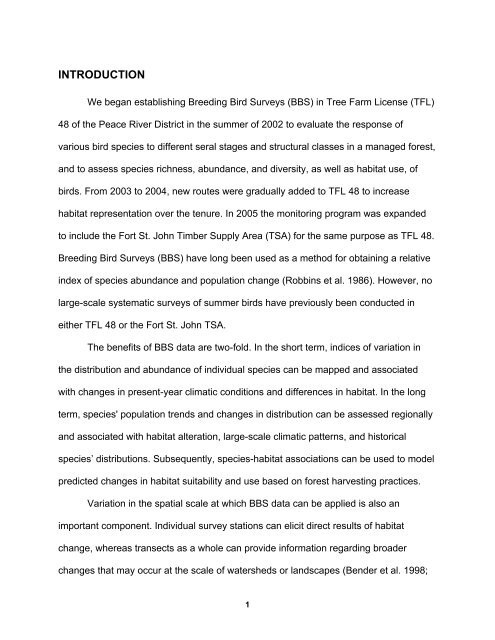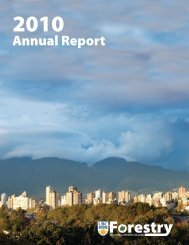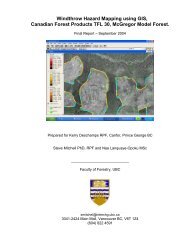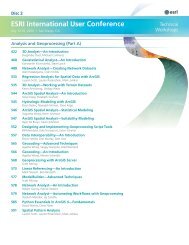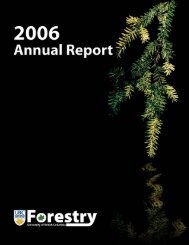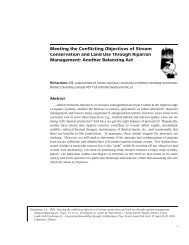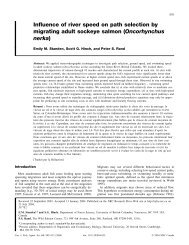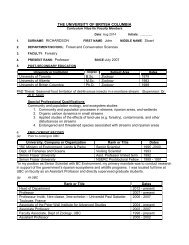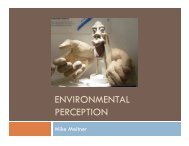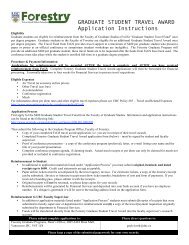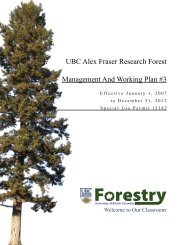A Four-year Summary of Breeding Bird Surveys in TFL 48 ... - BIOD
A Four-year Summary of Breeding Bird Surveys in TFL 48 ... - BIOD
A Four-year Summary of Breeding Bird Surveys in TFL 48 ... - BIOD
You also want an ePaper? Increase the reach of your titles
YUMPU automatically turns print PDFs into web optimized ePapers that Google loves.
INTRODUCTIONWe began establish<strong>in</strong>g <strong>Breed<strong>in</strong>g</strong> <strong>Bird</strong> <strong>Surveys</strong> (BBS) <strong>in</strong> Tree Farm License (<strong>TFL</strong>)<strong>48</strong> <strong>of</strong> the Peace River District <strong>in</strong> the summer <strong>of</strong> 2002 to evaluate the response <strong>of</strong>various bird species to different seral stages and structural classes <strong>in</strong> a managed forest,and to assess species richness, abundance, and diversity, as well as habitat use, <strong>of</strong>birds. From 2003 to 2004, new routes were gradually added to <strong>TFL</strong> <strong>48</strong> to <strong>in</strong>creasehabitat representation over the tenure. In 2005 the monitor<strong>in</strong>g program was expandedto <strong>in</strong>clude the Fort St. John Timber Supply Area (TSA) for the same purpose as <strong>TFL</strong> <strong>48</strong>.<strong>Breed<strong>in</strong>g</strong> <strong>Bird</strong> <strong>Surveys</strong> (BBS) have long been used as a method for obta<strong>in</strong><strong>in</strong>g a relative<strong>in</strong>dex <strong>of</strong> species abundance and population change (Robb<strong>in</strong>s et al. 1986). However, nolarge-scale systematic surveys <strong>of</strong> summer birds have previously been conducted <strong>in</strong>either <strong>TFL</strong> <strong>48</strong> or the Fort St. John TSA.The benefits <strong>of</strong> BBS data are two-fold. In the short term, <strong>in</strong>dices <strong>of</strong> variation <strong>in</strong>the distribution and abundance <strong>of</strong> <strong>in</strong>dividual species can be mapped and associatedwith changes <strong>in</strong> present-<strong>year</strong> climatic conditions and differences <strong>in</strong> habitat. In the longterm, species' population trends and changes <strong>in</strong> distribution can be assessed regionallyand associated with habitat alteration, large-scale climatic patterns, and historicalspecies’ distributions. Subsequently, species-habitat associations can be used to modelpredicted changes <strong>in</strong> habitat suitability and use based on forest harvest<strong>in</strong>g practices.Variation <strong>in</strong> the spatial scale at which BBS data can be applied is also animportant component. Individual survey stations can elicit direct results <strong>of</strong> habitatchange, whereas transects as a whole can provide <strong>in</strong>formation regard<strong>in</strong>g broaderchanges that may occur at the scale <strong>of</strong> watersheds or landscapes (Bender et al. 1998;1


